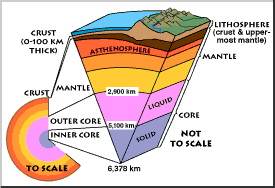May
6
Looking for the Deeper Oil And Gas
May 6, 2011 | Leave a Comment
A leader in a still quiet, but well funded and ambitious project is Jesse Ausubel of Rockefeller University (Of fame from his theory that the fuel economy will move from a highly carbon base to a more hydrogen enriched base). As Mr. Styles notes, “Although much is known about the behavior of carbon in the first seven miles or so of the earth’s crust into which we routinely mine and drill for resources, relatively little is known about the flows of carbon-based compounds in the other 99.6% of earth’s total volume.” That’s a bit of a reality check – only 0.4% of the earth’s crust has over 150 years yielded nearly 2 trillion barrels of oil and equivalents with very likely 2 to 3 and maybe 4 times that much more to come with the technology of today.
In the west the experts conclude that remains of plant growth has been processed into their present petroleum form by exposure to high pressures and temperatures over the course of millions of years to make the recoverable oil and gas of today. It seems completely plausible and the hard evidence can be seen in the coal seems readily dug up and examined, and put to use. The western view seems concrete and is – as far as it goes.
That begs the questions of Mr. Ausubel and the his involvement with the Deep Carbon Observatory, an international project of the Carnegie Institution to investigate the organic and inorganic carbon cycles deep in the earth. Here the effort is to ascertain what carbon exists even deeper that the top of the crust exploration has picked at for 150 years. As there is quite a lot of carbon working at the surface now, what might be of use from deeper in the crust?
The premise could be, especially for the thinkers in the east, Russia as a prime example, that hydrocarbon deposits could exist in that they were formed by chemical or biological activity much deeper in the earth (a pdf link), and then migrated long distances before being trapped. If that premise were even correct in part, that would mean that not only some of these fuels are not truly fossil in origin – and thus essentially static and finite – but that they might actually be continuously regenerated by natural processes in much shorter time spans than millions of years.
Here in the west the parallel to the Russian concept was best described by an idea developed by the Cornell University physicist Thomas Gold, who believed that oil and gas are produced by deep-earth microbes feeding on natural sources of methane. From this it followed, Dr. Gold argued, that oil wells might be naturally replenished from vast sources of carbon deep in the planet. Dr. Gold’s theories also have far-reaching implications for the origins of life on earth.
The puzzle for this writer is the notion that one or the other of the ideas is correct suggesting the other is wrong. Reality offers that both can be correct.
We do know the deep earth crust is populated by microbes that lead a largely independent existence from those on the surface. This dark world, flourishing but largely unknown, could have been the origin of life on earth and may influence it in many other ways. Add in the fact that the carbon on earth got here from a star going super nova billions of years ago. Keep in mind carbon is a lightweight element and is going to float up out of the mantle and core. These facts plus carbons’ quite handy ability to react with and form new molecules and the constant recycling of the crust from continental subduction and subsequent volcanic eruption and mountain building refreshes and re exposes carbon at the surface.
Most all the carbon on earth is likely in the crust and atmosphere dispensed from diamonds to methane and CO2. Whether or not there are organisms sending up hydrocarbon molecules and the speed of such production may not be terribly significant. But if a highly concentrated source is found a new rush to discover more would ensue.
Yet the carbon resource is all around us now. One day the technology of a solar cell taking in the atmospheric CO2 and humidity in the air making methane and O2 ready for use in combustion back to CO2 and water will be invented. That’s when there will be a seismic shift in market attention about carbon based fuel sources.
The difference between deep earth methane production and a methane solar cell is the time consumed to accomplish the reforming of the carbon. It’s a tall order to comprehend the millions of years involved in the geologic carbon cycle but very easy to grasp a solar cell making methane ready to heat the home, fuel the car or feed a fuel cell. To answer Mr. Style’s headlining question, “Are Oil and Gas Renewable” the answer is yes, of course, if you are patient enough.
A more thorough idea of what is going on way down deep is worth knowing. As with all great explorations the payoffs may well be something entirely other than the point of the original interest. Go! Mr. Ausubel, and please collect every possible data point along the way.


